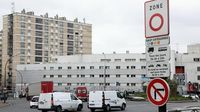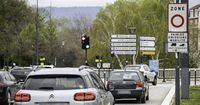The future of the "Zone à Faibles Émissions" (ZFE) in Greater Paris is now uncertain. On Wednesday, March 26, 2025, an amendment aimed at abolishing this measure was adopted by deputies in a special commission at the Assemblée nationale. While this decision has yet to become law, it has already sparked intense reactions.
On the social media platform Bluesky, Parisian ecologist deputy Sandrine Rousseau (EELV) condemned the health consequences of potentially abandoning the traffic restrictions, stating, "40,000 deaths per year in France," referencing figures confirmed by Santé publique France.
Established in July 2019, the ZFE in Greater Paris aimed to improve air quality and reduce fine particle emissions in the capital and its surrounding suburbs. To circulate within the ZFE, each vehicle was required to display the Crit’Air sticker, a classification system that ranks vehicles based on their pollution level. If the amendment is ultimately adopted by Parliament, these restrictions would disappear, allowing all vehicles to circulate freely in the 77 municipalities of the ZFE region.
David Belliard, deputy mayor of Paris in charge of public space transformation, expressed his concerns, stating, "Abolishing the ZFE would be a double penalty for the most modest," as reported by Actu Paris. When the ZFE was launched, it initially banned only the most polluting vehicles—those without classification and those classified as Crit’Air 5. The measure was tightened in 2021 and again in 2025, progressively excluding Crit’Air 4 and Crit’Air 3 vehicles. In 2022, over a thousand fines were issued in the ZFE of Greater Paris. However, provisions like the 24-hour ZFE pass, established by Belliard, allowed for occasional exemptions.
As a cornerstone of ecological policy in the capital, Belliard warns against dismantling this system. While he admits he is not its most fervent defender, he considers the ZFE to be "a useful tool, albeit one that can be improved." He recognizes the social criticisms regarding its impact and advocates for enhanced support mechanisms, such as purchase aids or conversion bonuses. "The ZFE is a liberal tool," he argues. "My position is to attach a strong social component. We cannot support a Hauts-de-Seine resident buying an SUV the same way we support a Seine-Saint-Denis resident who must change vehicles to reach the RER station before heading to work."
Belliard, an ecological candidate for the Paris mayoralty, intends to continue his advocacy with parliamentarians to ensure that the ZFE—especially that of Greater Paris—is not permanently abolished. He emphasizes, "It’s an important health tool; it would be a shame to do without it."
In response to criticisms of the ZFE, local authorities claim they are working on alternative solutions to assist motorists. "Patrick Ollier is very committed to finding measures that alleviate constraints, particularly through subsidies for electric vehicles or exemptions," a close associate of the president of the Greater Paris metropolis revealed. The ministry of ecological transition, led by Agnès Pannier-Runacher, reminded the public of the ZFE's beneficial effects: "In urban areas where they are implemented, such as Lyon and Paris, the concentration of nitrogen dioxide has decreased by more than a third." Conversely, the association 40 Millions d’automobilistes, which launched a petition against the ZFE on March 14, 2025, has already gathered nearly 27,000 signatures and celebrated the commission's vote as "a significant victory for motorists."
On the same day, the special commission of the Assemblée nationale voted to remove the ZFE against the government's advice, citing their impact on low-income households. The project will be presented to parliamentarians on April 8, 2025. Are we soon to witness the end of the Crit'Air stickers and the traffic restrictions in the ZFE?
The ZFE was established by the 2019 Mobility Orientation Law and later expanded to several metropolitan areas, including Marseille, to limit air pollution responsible for respiratory diseases and 40,000 deaths annually, as per Santé Publique France. The two amendments adopted by the Republicans and the National Rally on March 26 argue that the ZFE penalizes lower-income households. Despite a "laudable" objective, the ZFE "exacerbates social inequalities," forcing low-income families to choose between significant additional costs to purchase a new clean vehicle or forgoing travel altogether, justified Deputy Ian Boucard (Territoire de Belfort, Républicains) on behalf of his group.
The ZFE is increasingly criticized, but this vote in commission does not immediately abolish them; it is merely the first step. The text will be examined in the Assembly and the Senate starting April 8. All deputies must vote on the same text in a public session as a parliamentary shuttle occurs for a matching vote in the Senate. Since January 1, 2025, the system has extended to 42 urban areas with over 150,000 inhabitants, which has intensified scrutiny. Some municipalities, hesitant about the ZFE, are seeking to delay implementation, such as Toulon, which decided last December not to apply it with the prefecture's approval.
Protests are planned in several cities on Sunday, April 6, 2025, with participation from various groups. If the ZFE system is abolished, France would risk being in violation of European regulations. A directive from the European Parliament and Council of May 21, 2008, mandates member states to implement measures to not exceed air pollution limits in urban areas. In a statement, Minister Agnès Pannier-Runacher acknowledged the vote and plans to propose a joint initiative in the coming days to continue health protection efforts with local elected officials in major urban areas where air pollution significantly exceeds international recommendations.
The ZFE has been in effect in Marseille since September 1, 2022, banning vehicles equipped with a Crit’Air 5 vignette from circulating in the city center. In 2023, the Aix-Marseille metropolis, alongside Strasbourg and Rouen, fell below regulatory air quality thresholds, allowing it to postpone the ban's implementation for Crit’Air 3 vehicles, initially set for January 1, 2025. The president of the metropolis, Martine Vassal, had already announced an indefinite postponement of the Crit’Air 3 vehicle ban, explaining, "Not everyone can afford to switch to an electric vehicle in such a short time."
As discussions around the ZFE continue, many motorists remain hopeful that the deputies will follow through with the complete abolition of the ZFE. In Strasbourg, for instance, Martin, a local driver, shared his disdain for the ZFE, stating, "I have a 2005 Volkswagen that is Crit’Air 4, and I refuse to buy the Crit’Air sticker, risking a €45 fine when I come to the city. The Crit’Air 3, 4, and 5 stickers are worthless now; it’s double punishment: we can’t drive with them and can’t sell them either."
As the debate unfolds, the outcome remains uncertain, but one thing is clear: the future of the ZFE and its impact on urban air quality is a pressing issue that will continue to resonate with the public.









